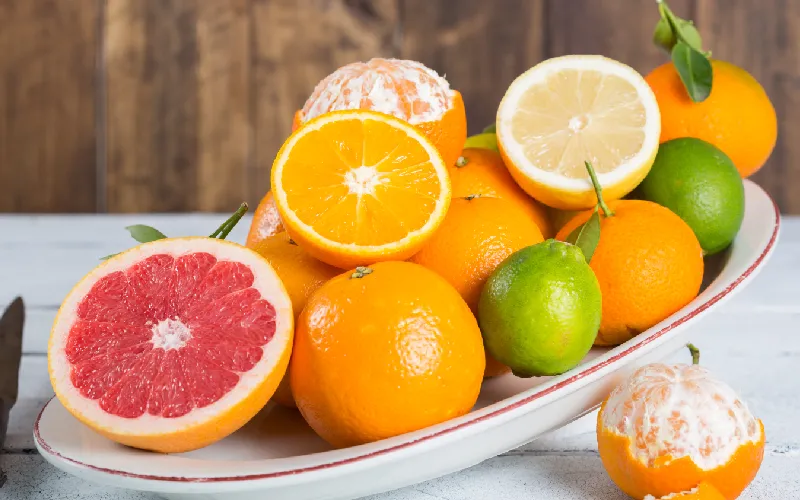Sour fruits, known for their flavor and rich nutrient profiles, include apples, strawberries, grapes, oranges, blueberries, lemons, pineapples, and raspberries, which rank among the most popular choices in the United States. These fruits are frequently in the food industry for creating various consumer products like preserves, juices, jams, and desserts. Also, in the dairy and ice cream industry to create new flavors in their products (The Packer, 2021; Mordor Intelligence, 2023).
The food industry uses these four sour fruits to change the flavor of products.
1. Strawberries, one of the most widely consumed sour fruits
Firstly, strawberries rank among the most consumed fruits in the United States and earn high regard for their pleasant flavor, enticing aroma, and vibrant red color. Moreover, they boast high levels of vitamin C and basic minerals. This fruit is suitable for raw, fresh consumption and is available in various forms such as fruit pulp, purees, frozen, and concentrated (Acuña, 2020).
Certainly, it holds significant industrial value, and the food production industry recognizes it as a vital ingredient, particularly in the creation of diverse flavored products. These products encompass compotes, fruit desserts, jams, juices, yogurts, jellies, ice cream, and more (Acuña, 2020).
2. Pineapple, among the most demanded sour fruits in the world
Pineapple stands as one of the world’s most sought-after fruits, renowned for its rich nutrient content, including vitamin C, B1, B9, and E, as well as minerals and fiber. Moreover, it is famous for its distinctive flavor and the extensive array of available varieties. The most popular presentation is as fresh fruit, cut and packaged in bags or trays.
In the market, it comes in various forms, including canned whole slices and pieces, as well as pulp and purees. For instance, the food industry utilizes pineapple as a raw material in crafting simple or concentrated juices, syrups, jellies, candied fruits, and as a base for producing dairy products like yogurt and ice cream, among others (UN, S.f.; Betancourt et al., 2021).
3. Passion fruit, one of the sour fruits with intense flavor
Passion fruit ranks among the exotic fruits known for its intense and distinctive acid flavor. It boasts a highly characteristic strong aroma and retains its vibrant color in any of its forms. The pulp encases small seeds that develop within a robust shell providing protection. It is available as a processed product in the form of fruit pulp, purees, or concentrates (PROCOLOMBIA, 2019).
Known as passion fruit, this is abundant in vitamin A and C, along with antioxidants like flavonoids and alkaloids. The food industry frequently employs it for crafting juices, desserts, jellies, and various other products. Its vibrant flavor retains exceptionally well, making it a valuable ingredient for enhancing the taste of industrialized products (PROCOLOMBIA, 2019; Lemus, S.f.).
4. Guava, a fruit that provides a lot of flavor
Guava fruit contains a rich array of nutrients like vitamin A and C, fiber, and antioxidants. It possesses a mild flavor, ranging from mildly acidic to slightly sweet; with pulp varying in colors of pink, white, red, or yellow. The primary product derived from guava is its pulp. In addition, is available in various forms, including fresh fruit, frozen pulp, purees, concentrates, and more.
This fruit serves as a raw material for producing numerous food items; for example, imparting its distinctive flavor to juices, nectars, desserts, preserves, jams, ice cream, gelatins, wines, and various other products (Buitrago et al., 2021). In conclusion, sour fruits are distinguished by their nutritional richness and delightful, intense flavor. They serve as valuable ingredients in the food industry; subsequently, enhancing the flavor profile of many products or offering a unique taste to existing ones. Strawberry, pineapple, passion fruit, and guava represent excellent options for infusing a new flavor into food products.
Bibliographic References
- Acuña, J. (2020). Strawberry (Fragaria × ananassa Duch.): Manual of technical recommendations for its cultivation in the department of Cundinamarca. National University of Colombia, Bogota.
- Betancourt, J., Fernández, D. and Moreno, A. (2021, November 25). Export opportunities of pineapple (Ananas comosus) in the French market. University of Cundinamarca, Facatativá, Colombia.
- Buitrago, G., Bustamante, S., Corredor, G., Saavedra, J., Pinzón, Y. Pinzón, D., Pérez, D. and Diaz, D. (2021). Guava (Psidium guajava): Manual of technical recommendations for its cultivation in the department of Cundinamarca. Universidad Nacional De Colombia, Bogotá.
- Lemus, G. (S.f.). Passion fruit. A new species that can be incorporated in the central zone. Agricultural Research Institute – INIA, Chile.
- Mordor Intelligence (2023). Fruit and vegetable processing market: global trends, impact and covid-19 forecasts (2023 – 2028).
- PROCOLOMBIA. (2019, February 19). 5 exotic Colombian fruits you can’t miss to try.
- The Packer. (2021). Fresh Trends 2021.
- UN. (S.f.). Pineapple.







